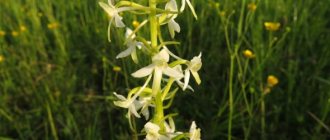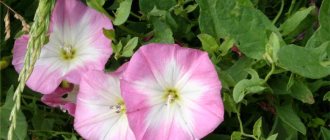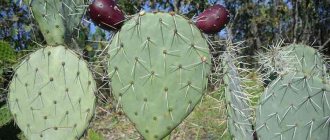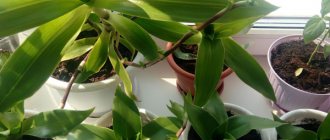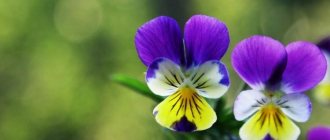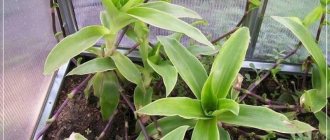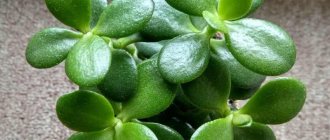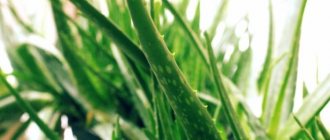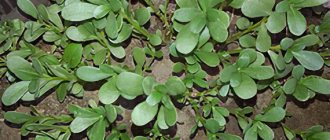- Description of Oregano
- How to grow oregano?
- Choosing a place for oregano
- Growing oregano with seedlings
- Propagation of oregano by dividing the bush
- Propagation of oregano by cuttings and layering
- Oregano care
- Cutting and storing oregano
- Application of oregano
Oregano: photo, description, cultivation and care. Oregano (Origanum vulgare), or as it is called in Europe - oregano, is a distant relative of the well-known mint, lemon balm, sage, basil and other herbs. Oregano has high, valuable nutritional and medicinal properties, as well as a magnificent aroma. As a spicy crop, oregano has long been used in the cuisines of the peoples of Europe and the Mediterranean. Oregano is almost the most important spice for making the legendary pizza in Italy and Greek salad. The plant has a rich source of antioxidants, containing ascorbic acid, essential oil and tannins. Given this, oregano is widely cultivated throughout the world.
Oregano, or Oregano (Origanum vulgare).
In its natural habitat, oregano is a herbaceous plant growing in the southwestern part of Europe and especially in the Mediterranean. In our country, the favorite habitats of oregano are forest edges, clearings open to the sun and wind, as well as dry and extensive meadows.
Oregano is familiar to people as a perennial, spicy and herbal crop, which is often used not only in cooking, as we have already mentioned, but also in landscape gardening and decorative art and even in folk medicine. Oregano also has other names, for example, in our country they call it motherwort. Thanks to the work of breeders, many varieties of oregano have been created; there are 16 names in the State Register of Russia, and there are also many new products created just a couple of years ago, these are the cultivars: Fragrant Bunch, Winter, Honey Aroma and Ogranza.
Are oregano and thyme the same thing?
Oregano and thyme are different plants, although they both have medicinal properties and are widely used in cooking. The differences are noticeable even externally. Thyme is a subshrub that spreads along the ground, while oregano herb (oregano), on the contrary, is a tall-growing species. The aroma of the flowers of the plants is very similar, but the inflorescences are very different.
How to cultivate?
This plant loves the sun and tolerates lack of moisture well, so choose sunny areas for planting. The soil is with a neutral acidity level, sandy loam. Oregano looks good among other perennials in the rock garden.
The plant propagates by seeds and division of the bush. Seeds are planted outside in the fall in closed greenhouses. Planting depth is 1-1.5 cm. Seeds are sown for seedlings at the end of March. Then the grown plants are planted in open ground at the end of May, protected from night frosts.
Oregano reproduces well by dividing the rhizome and layering. The bush can bloom in the first year of life, but young buds should be removed so that the plant does not lose vigor on flowers.
Description
Oregano has many names, including:
- forest mint;
- amulet;
- motherboard;
- darling;
- bee lover;
- zenivka;
- boron bone-breaking grass.
This perennial crop belongs to the Yastnotkov family.
In nature, this plant can be found in Europe and the Mediterranean. Oregano most often grows on:
- clearings;
- meadows;
- river banks;
- hillsides.
The top of the plant is branched. The stem is tetrahedral, covered with small hairs. The height of oregano reaches an average of 60 cm, but it can grow up to 1 meter. The plant has a branched and creeping root system. The leaves are oblong and ovoid in shape.
Oregano blooms in July; the flowers are small in size and have a purple tint; the inflorescences are thyroid-paniculate. The fruit is oval, divided into 4 dry nuts.
Oregano grows in almost any soil. Has a pleasant aroma. The plant prefers open areas. Oregano tolerates the cold and winter months easily and comes to life already in early March.
Growing conditions
Oregano is considered a very unpretentious plant. Its cold resistance, which allows this crop to grow well and winter in harsh conditions, makes it possible to grow it even in the northern regions.
Permeable nutrient soils with neutral acidity are best suited for this spicy crop. It does not tolerate acidic and clayey soils. The place for growing must be chosen in sunny areas. Only young specimens can tolerate slight shading.
Another advantage of oregano is drought resistance. But only adult plants have it. During germination, emergence of seedlings and the formation of the first few pairs of true leaves, seedlings require a lot of water.
In the first year of life, this crop blooms quite late (late August - early September), so the fruits do not have time to fully ripen. In subsequent years, oregano shoots begin to grow from April 10 to May 10, so flowering begins in July, and, accordingly, the seeds ripen in September.
Chemical composition
More than 1% of essential oil is contained in the leaves and stems of the crop. This plant also contains the following elements:
- 20% carvacrol;
- up to 10% thymol;
- 12.5% sesquiterpene;
- 15% free alcohols;
- up to 5% geranyl acetate;
- vitamins B1, B2, C, D, A, K.
Also contains:
- tannins,
- fixed oils,
- ascorbic acid.
There are only 25 kcal in 100 grams of the plant.
The properties of oregano are determined by the chemical composition of the plant:
- Essential oils help cope with neurosis and get rid of insomnia.
- Tannins have choleretic and diuretic effects.
- Timol is an antiseptic.
- Alcohols and ascorbic acid help increase appetite.
Useful properties of the plant
- For insomnia, increased nervous irritation, neuroses, hysterics, and stressful situations, a decoction prepared from the leaves and flowers of oregano, the essential oils of which have a calming effect, will help.
- An infusion or decoction of oregano will help relieve pain, improve intestinal motility, cope with symptoms of flatulence, and as a prophylactic for gastrointestinal disorders.
- Drinking oregano tea is recommended for headaches and migraines, as this plant has an antispasmodic effect.
- The plant can be used as a remedy for respiratory diseases, since oregano helps in the removal of sputum, as well as bronchitis and pneumonia.
- This culture is used in the treatment of adults and children who have become infected with worms.
- Oregano will also help cope with diseases of the genitourinary system and liver, since this plant has a choleretic and diuretic effect.
- A decoction of oregano will help eliminate rashes, acne, boils, and pimples. The plant helps to quickly cope with skin irritation, allergies, psoriasis, and other dermatological ailments.
- To prevent cancer, it is also recommended to regularly drink oregano tea, since the components contained in the leaves, stems and flowers of the plant will help protect the body from the spread of cancer cells.
- Oregano is used to combat cellulite and improve skin condition, as it helps to easily restore the condition of the subcutaneous fat layer.
- Preparations prepared from this plant help restore the menstrual cycle and easily cope with the painful manifestations of PMS, but such treatment can only be carried out under the supervision of a doctor.
- Nursing mothers will produce milk much more actively if they take oregano preparations correctly.
- Oregano is a unique antiseptic gift from nature itself.
- Inhalation with a decoction or with the addition of oregano essential oil helps with colds, coughs and eases breathing.
- Sore joints and rheumatic symptoms can be treated with oregano essential oil, which is recommended to be rubbed into problem areas.
Oregano decoctions and infusions will also help normalize blood pressure, improve appetite, and get rid of toothache.
Watch the video! Oregano is a herb that restores the body
For women
Oregano is of particular value for women's health.
- Medicines prepared from the plant are actively used in gynecology and help cope with polycystic ovary syndrome, cervical erosion, amenoria and other pathologies of the reproductive system.
- Infusions and decoctions of oregano will also help in the fight against bleeding; they are recommended for use by women after childbirth to speed up the healing of the uterine mucosa.
- Oregano will also help cope with pain during menstruation and the unpleasant symptoms of menopause.
- An infusion of oregano will help cope with vaginal itching and other female diseases, and this remedy will also help stabilize the monthly cycle.
- Nursing mothers with insufficient lactation need to consume oregano extracts, which activate the production of breast milk.
- Oregano decoction helps to cope with severe hair loss, improve its condition and accelerate growth.
- Drinking tea with oregano helps remove toxins from the body, improve the functioning of the gastrointestinal tract and cleanse the intestines.
- You can add other medicinal herbs to the oregano decoction to enhance their positive effect.
Monastic tea
To prepare “Monastic tea” you need to take the following components:
- St. John's wort -1 tbsp. l,
- chopped elecampane root - 1 tbsp. l,
- oregano -1 tbsp. l;
- rose hips – 100 gr.
- should be mixed and filled with water (3 liters);
- Boil;
- Leave for 1 hour;
- The drink can be stored in the refrigerator and consumed cold.
Important! Do not forget about contraindications.
Decoction
To prepare a decoction with oregano you need to take:
- oregano 100 gr;
- thyme 50 gr;
- yarrow 50 g;
- honey 100 gr.
The resulting mixture is poured with boiling water and infused for 2 days. It is recommended to drink the infusion 200 ml 3 times a day. The course should be carried out within a week.
Infusion
During menopause, you should regularly drink an infusion prepared according to the following recipe:
- oregano 50 gr;
- thyme 50 gr.
- The herbs are crushed and placed in one container;
- 100 ml of alcohol should also be poured there;
- Infuse the resulting mixture for a week;
- The infusion should be consumed 1 teaspoon 3 times a day. The duration of the course is one month.
Botanical characteristics
Oregano is a plant with herbaceous, branched shoots, which often form a subshrub 30-75 cm in height. Its roots are bare and horizontal, so the plant is capable of spreading and capturing new territories. The erect tetrahedral stem has sparse hair at the base.
Opposite ovoid or oval leaves grow densely along the entire length. They have solid edges and a pointed end. The dense dark green surface is dotted with a network of veins. The reverse side has a grayish tint. The length of the leaf plate is only 1-4 cm.
From July to August, the top of the shoot is decorated with a dense panicle inflorescence. It contains small tubular flowers of gray-pink or purple-pink color. Each corolla is surrounded by a dark red-violet bract. The flower has a bilabial structure with an underdeveloped lower lip. Stamens protrude from the center.
After pollination, cylindrical seed pods with a reddish crown on top and ribbed sides ripen. Inside are small kidney-shaped seeds with dark brown skin. There are about 10,000 units in 1 g of seed material.
Oregano during pregnancy: contraindications and use
Even with a normal pregnancy, oregano will be useful. Expectant mothers are recommended to use the following recipe:
- 100g oregano;
- pour 1 liter of boiling water;
- Drink the resulting decoction throughout the day.
Advice! Increased tone of the uterine walls is a reason to refuse to use this plant, since the components in its composition can cause premature birth or miscarriage.
For men
Alcohol addiction in men can be overcome with the help of a decoction of oregano, but at the same time sexual activity will decrease.
Attention! Regular use of this drug can lead to the development of impotence.
For children
- To treat children from rickets and scrofula, oregano is used in folk medicine.
- Bathing in oregano decoction will help eliminate redness on your baby’s body and cope with allergic rashes.
- Soothing tea with oregano is recommended for children with increased excitability and sleep disorders.
- Bloating, colic and flatulence in a child can also be overcome with a drink based on this amazing plant.
- This culture, used as an infusion, will help relieve inflammation in the throat with a sore throat and eliminate stomatitis in a child.
- Herbal infusions, of which oregano is an integral part, are used to relieve cough in children with whooping cough. To treat colds and relieve asthma attacks, it is also recommended to use oregano. It should be remembered that treatment of a child with decoctions of this herb should only be carried out under the constant supervision of a doctor. Because the components of this plant can have a serious impact on puberty, especially in adolescents.
Oregano care
During the first year of growth, oregano should be provided with good and timely care; special attention at this time should be paid to weeding, watering and fertilizing.
Watering
Such a crop does not particularly need regular watering, but the soil should not be allowed to dry out completely. In this regard, the soil should be moistened as necessary when its surface dries out.
Oregano can be damaged by stagnant fluid in the root system. Particular attention should be paid to this during prolonged rains. In this regard, it is recommended to make not very large depressions in the ground around the bushes.
Fertilizer
You should start fertilizing oregano in early spring, and it will also need nutrients after harvesting. During the first year of growth, young bushes do not need additional fertilizers, since they have enough nutrients in the soil prepared in the fall. Starting from the second year of growth, bushes should be fertilized regularly. In early spring, when the bushes just begin to wake up, it is recommended to feed them with a small amount of mullein solution or saltpeter. In the summer, you can also use the same fertilizers. Oregano, cultivated as an ornamental plant in a flower bed, does not need fertilizing, as this causes the bushes to actively grow, making them less decorative.
Weeding and loosening
The soil in the garden bed with oregano should always be slightly loosened. During the first year of growth, while the bushes are still very weak, they should be systematically weeded. The fact is that oregano does not grow very quickly, and weeds on nutritious soil grow rapidly and begin to choke the plant. However, after the perennial bushes get stronger and grow, they will no longer be afraid of any grass. If you want to water the bed with oregano less often and reduce the number of weedings, then cover its surface with a layer of mulch (straw).
Please note that if flowers appear on the bushes during the first year of growth, they must be cut off. The fact is that they take a lot of strength from the young plant, and it is still weak.
Wintering
Oregano is highly resistant to frost. In this regard, it does not require shelter for the winter. If the snow cover falls early in the fall, then when it melts in the spring, you will still be able to see green leaves on the bushes.
Transfer
You can grow such a perennial in one place for about two decades. But in the case when oregano is grown to obtain medicinal raw materials, it should be transplanted to a new place regularly: once every 5 years. You can plant anything in a plot freed from oregano, and be sure that in this place the crop will not be afraid of both diseases and pests. The fact is that oregano contributes to the death of pathogenic bacteria and pests in the soil.
Trimming
To improve the growth of bushes, experienced gardeners advise breaking off some of the stems left over from last year in the spring. Soon the growth of new, more powerful shoots will begin, and the foliage on them will be very dense.
FRAVOUS ORIGINAL SEASONING, From A to Z,
Oregano in cosmetology
This aromatic plant is used very often in the preparation of cosmetics. Oregano-based products are used to care for the face, body and hair. This plant became famous due to its unique properties:
- elimination of skin diseases, acne, acne;
- restoration of the skin, rejuvenation;
- cleansing the scalp from dandruff, improving hair structure;
- giving the skin elasticity, firmness, and silkiness.
Many masks and creams are made based on oregano. These products can be used both to maintain the freshness of young skin and to aging skin. Oregano also contains a special pigment that allows you to create a tanning effect.
You can prepare cosmetics from this plant at home.
Watch the video! Oregano (oregano) medicinal properties
Mask
For face
- Art. spoons of fresh oregano leaves;
- pour 1 glass of boiling water;
- Hold for 10 minutes;
- Add protein;
- Mix and apply to hair for 30 minutes;
- After half an hour, wash off the mask.
Using this product will help to significantly tighten the pores of the scalp, especially if it is oily.
Anti-wrinkle
- 1 tbsp chopped oregano;
- Fill with hot water (100ml);
- Leave for 3 hours;
- Next, the mixture is filtered and 1 tablespoon of olive oil is added to it.
The product should be applied to the face and washed off with water after half an hour.
To strengthen hair
- 3 tbsp chopped oregano;
- pour 500 mg of boiling water;
- leave for 30 minutes;
- Strain the cooled solution and add 2 tablespoons of honey.
Rub the product into the scalp and leave for half an hour, then rinse with water. This mask will help improve the appearance of your hair and prevent hair loss.
Ice for facial skin
- 2 tablespoons of leaves and stems of the plant should be chopped;
- pour boiling water (200 mg);
- leave to brew for 25 minutes;
- the liquid is filtered;
- pour into prepared small molds and place in the freezer.
It is recommended to wipe your face with the resulting ice pieces in the morning. This procedure will help make your facial skin fresh and tightened.
Decoction for rinsing hair
- 4 tbsp chopped oregano;
- Add 0.5 liters of boiling water;
- Boil the mixture over low heat for 10 minutes after boiling;
- The mixture should be left to sit for 1 hour.
The solution is recommended to be used as a rinse after each hair wash. The product will help make your hair silky, shiny, and also get rid of dandruff.
Cleansing toner
- 1 tbsp chopped oregano;
- pour 1 glass of boiling water;
- leave for 30 minutes, then filter.
The resulting infusion should be wiped on the face in the morning and before bed. After some time after use, the result will be noticeable - the skin of the face will become smooth and velvety, and also noticeably cleansed.
An infusion of oregano added to a cool bath will help relieve swelling in the legs after a long walk.
Spreading
Oregano oregano The homeland of oregano is the Mediterranean, but it generally grows throughout Europe on calcareous and gravelly soils in warm places, such as southern slopes and slopes, southern forest edges and dry meadows.
Oregano is widespread in the European part of Russia, the Caucasus, Western and Central Siberia, Central Asia and Kazakhstan.
Habitats . It grows in areas of meadow steppes, thickets of bushes, clearings and clearings in oak and pine forests, as well as in birch forests.
Oregano (motherland). Teberda Nature Reserve. In the meadows, mountains. steppe slopes and edges, 1300-2000 m above sea level. Everywhere, usually.
Traditional medicine recipes
Decoctions and infusions prepared with oregano have long helped people cope with various diseases:
Insomnia
An infusion that will help cope with insomnia is very easy to prepare. It is enough to take:
- 4 tbsp chopped herbs;
- pour 2 cups boiling water;
- then leave to infuse for 25 minutes.
Neuroses, epilepsy
- 2 tbsp herbs;
- pour 0.5 cups of vodka;
- leave for a week in a dark place;
- after which the mixture is filtered.
The resulting solution should be consumed before meals, 1 tsp.
Allergies in children
- oregano flowers (3 tbsp);
- pour 2 liters of hot water;
- leave for 30 minutes.
The strained infusion is used to bathe the child.
Runny nose
Dried oregano flowers are ground into powder and used as a snuff.
Angina
- In 0.5 cups of boiling water;
- Add 1 tbsp chopped oregano;
- Leave for 25 minutes.
The composition is filtered and used for gargling.
Menstrual irregularities
- 1 tbsp herb;
- pour hot water;
- leave for 40 minutes;
- after which it is filtered and used daily, drinking 1 glass per day.
Cataract
- 1 glass of boiling water;
- pour 1 tablespoon of chopped herbs;
- leave for 1 hour;
- filter and take half a glass 3 times a day 20 minutes before meals.
The resulting remedy helps slow the spread of cataracts, and can also be used for multiple sclerosis and epilepsy.
It is recommended to drink the juice of the plant to eliminate attacks of epilepsy, for colds and to improve the functioning of the digestive organs. This remedy is used as a hemostatic and sedative. Skin diseases can also be treated using oregano juice.
Compresses against flatulence and abdominal pain in children can be prepared from steamed oregano leaves.
A bit of folklore
Oregano, oregano, motherwort,
People call her differently.
It is believed that a magical blade of grass
It will reliably protect you from evil spirits.
In the popular dictionary there are different names for oregano - spiritual flower, bone-breaking herb, forest mint, motherwort, flea herb. This suggests that it is very widely used.
Russians associate oregano with the reign of Peter I. Once the tsar, disguised as a traveler, asked to spend the night with a housewife. Only he couldn’t sleep in someone else’s house. The hostess gave the unknown wanderer a miraculous decoction, which helped him relax and sleep until the morning. In the morning, the king, full of strength, asked about the girl’s name and what potion she gave him to drink. All her relatives called her Oregano, and the grass was called fragrant calm.
The girl had no idea that she was dealing with the emperor himself. He ordered the herb to be named after her name - oregano. The king left, and the plant began to be called that way in Rus'. This is, of course, a legend, but with meaning.
There are also beautiful superstitions associated with the name “motherboard”. It was believed that if you sleep on a pillow made of dry oregano, you will have an excellent memory, allowing you to remember your mother, your homeland, your childhood.
Oregano is especially widespread in Ukraine. There is also a legend about a deceased mother and her unfortunate children who cried endlessly at her grave. From their tears, a beautiful fragrant flower blossomed on the grave. The children saw their mother in him, so they named him mother.
And today, among the expanse of lush grasses in the forest oak groves, the beauty of the motherland flaunts and smells. This perennial plant is known to the entire rural population, and many city residents. There are many dialect names for the flower: incense, matserdushka, zenovka, matryoshka.
Oregano tea
Tea made from oregano has a pleasant aroma. A cup of this decoction will help relieve fatigue, as well as fill the body with useful substances. You can prepare this drink as follows:
- 1 tbsp chopped herbs;
- pour 1 cup boiling water;
- leave to infuse for 10 minutes.
This tea should only be consumed warm. It is also recommended to use it to relieve nervous tension, rheumatism and liver disease.
Advice! This solution will be useful for bronchitis.
It should also be used for gynecological diseases. The decoction has a diuretic and diaphoretic effect, helps remove excess water from the body and cope with infection in the kidneys.
Regular use of the infusion improves appetite, strengthens the immune system, and also eliminates bad breath.
Collection and storage of medicinal herbs
The upper part of the plant is used for cosmetic and medicinal purposes. At the end of July, when oregano is actively blooming, the plant should be collected. You can only collect healthy shoots with blossoming flowers and green leaves.
The raw materials should be dried outdoors under a canopy.
Oregano should be stored separately from other herbs in a cardboard box or glass jar. The container with dry grass should be in a dark and dry place.
Reference! For 3 years, if properly stored, oregano can retain its medicinal properties.
Leaves and flowers of the plant, when frozen, can be stored in the refrigerator for 2 years.
Reproduction methods
How to propagate oregano using the seed (generative) method was described in great detail above. However, vegetative methods are also used to propagate this plant.
Dividing the bush
Remove the mature, overgrown bush from the soil and divide it into a couple of parts. Be very careful, because the shoots should remain intact after division, and the root system cannot be damaged much.
By layering
If you need oregano layerings, then throughout the growing season, select individual powerful stems, bend them to the soil surface and dig them in. Over time, they should all take root of their own. With the onset of next spring, cut off the new bush with a sharp shovel and plant it in a new permanent place.
It is recommended to transplant either layering or divisions to a new place in the spring or in the first weeks of autumn. In this case, the bushes will have enough time to take root well in the new place before the onset of frost.
Contraindications
- Pregnant women should use oregano in any form with caution, since the components contained in the plant, affecting the tone of the walls of the uterus, can cause miscarriage or premature birth.
- People suffering from peptic ulcers, exacerbation of gastritis and other diseases of the gastrointestinal tract are not recommended to eat the plant fresh.
- People who suffer from individual intolerance should not use oregano in any form.
- Constant, unlimited use of oregano decoction contributes to the appearance of headaches, dizziness, nausea, and allergic rashes.
- Constipation can be caused by tannins contained in the plant.
- Heartburn and irritation of the mucous membranes can be caused by ascorbic acid, which is also present in the leaves and stems of oregano.
- Uterine bleeding is caused by the use of a concentrated decoction of oregano.
- Eating oregano can affect male potency, so men should not drink decoction and tea based on it often.
Oregano can be used as a medicinal product only after consultation with your doctor.
Watch the video! Oregano - medicinal properties
Interesting Facts
Oregano is one of the most popular spices. The herb is known on all continents and is used in many spice mixtures. In its pure form, it is a common ingredient in savory vegetable salads.
Features of the use of spicy herbs:
- In terms of ascorbic acid content, oregano is the leader among the main spicy crops of the Yamnotaceae family.
- Scientists are studying the composition of oregano, as there is an assumption that it can be used to make antibiotics that act on those bacteria that are not sensitive to existing antibacterial pharmaceuticals.
- The plant is included in dietary supplements for heart patients and hypertensive patients in many countries around the world.
- In Rus', oregano was used to enhance the taste of kvass and oatmeal, and was added to mead.
- A whole line of Korean cosmetics has been created with oregano extract for women of different ages.
- Oregano is added to marinades when soaking meat and poultry for barbecue not only for the sake of taste, it breaks down fats and improves the absorption of food.

